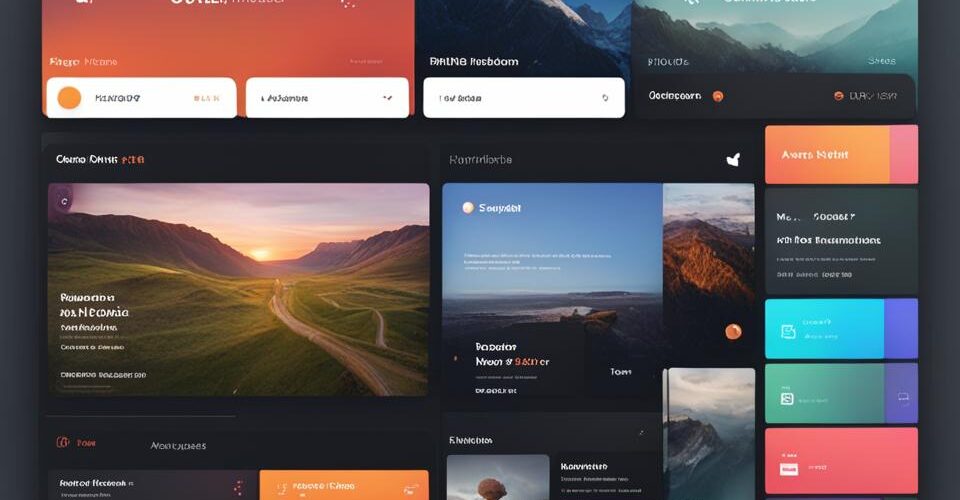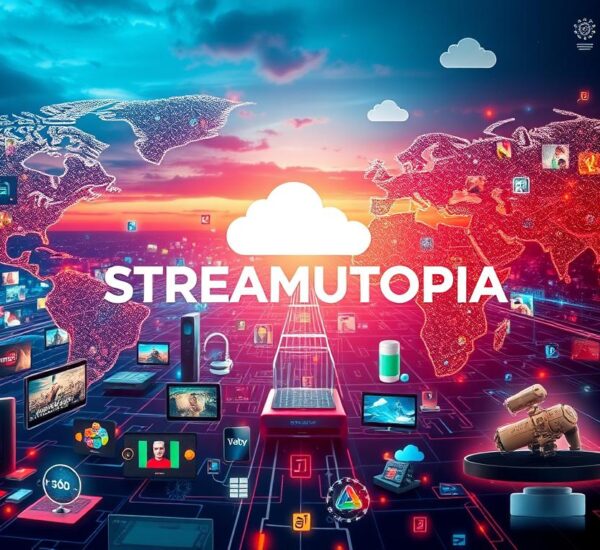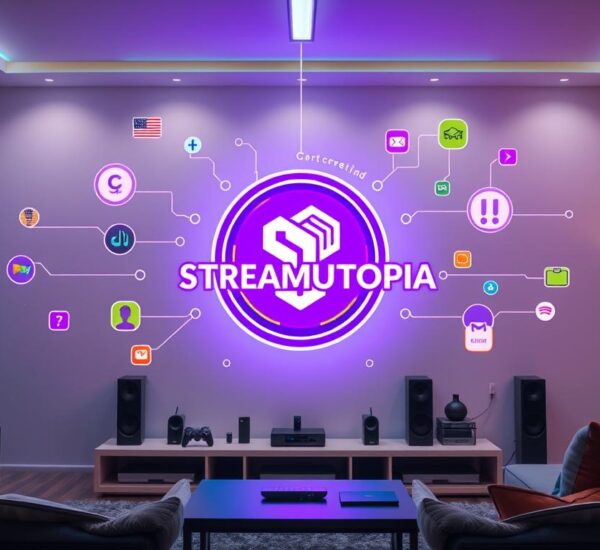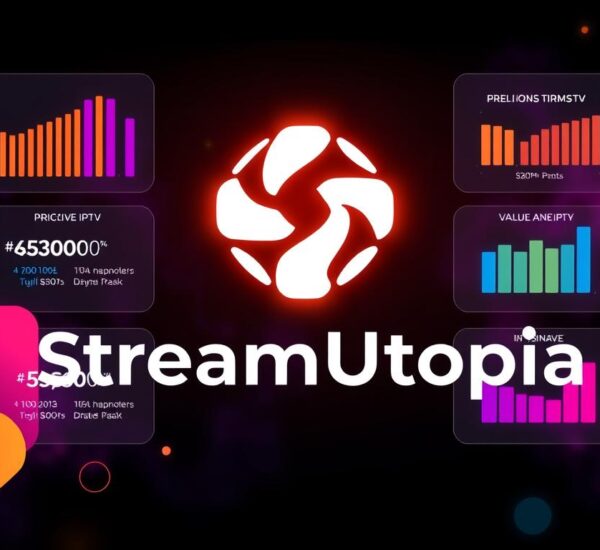Did you know that user experience design in streaming platforms has become a major factor in the success of IPTV services? As viewers increasingly turn to digital platforms for their entertainment needs, the importance of intuitive interfaces, seamless navigation, and engaging content discovery mechanisms cannot be overstated.
Key Takeaways:
- User experience design is crucial in the success of IPTV services
- Intuitive interfaces, seamless navigation, and engaging content discovery mechanisms are vital in streaming platforms
- IPTV services focus on user-centricity and employ research-driven methodologies
- Personalization, multi-platform integration, and accessibility are key aspects of IPTV interfaces
- The design and user experience in IPTV platforms shape the future of the entertainment industry
Understanding the User Journey: Mapping the Viewer Experience
IPTV services place a strong emphasis on user experience design, recognizing the importance of understanding the viewer journey to create seamless and intuitive experiences. By employing research-driven methodologies, these services gain valuable insights into the pain points, preferences, and behavior patterns of their target audience. This deep understanding allows IPTV platforms to anticipate user needs and design interfaces that keep viewers engaged and satisfied.
Through a comprehensive analysis of the user journey, IPTV services identify key touchpoints and optimize each interaction to enhance the overall viewer experience. By mapping out the various stages of the user journey, from initial content discovery to content consumption and beyond, these services can strategically align their design and functionality to meet and exceed user expectations.
Whether it’s simplifying the registration process, improving content recommendations, or streamlining the navigation menu, every aspect of the IPTV interface is carefully designed to enhance the user journey. By addressing pain points and incorporating user feedback, IPTV services continuously iterate and improve their platforms, ensuring that every step of the user journey is seamless and satisfying.
An illustrative representation of the user journey, showing the various touchpoints and interactions between the viewer and the IPTV platform.
Key Benefits of Understanding the User Journey
- Enhanced User Engagement: By mapping the viewer experience, IPTV services can identify opportunities to create more engaging content, features, and functionalities that resonate with their audience.
- Improved User Satisfaction: Through a user-centric approach, IPTV platforms can proactively address pain points and optimize the user journey, resulting in higher levels of user satisfaction.
- Increased Content Consumption: By designing intuitive interfaces and personalized recommendations, IPTV services can encourage users to explore and consume more content, maximizing their time and investment in the platform.
User Journey Mapping Best Practices
- Conduct User Research: Utilize qualitative and quantitative research methods to gain insights into user behavior, preferences, and pain points.
- Create User Personas: Develop fictional representations of target audience segments to better understand their needs, motivations, and goals.
- Identify Touchpoints: Map out the various touchpoints where users interact with the IPTV platform, including content discovery, playback, and engagement.
- Optimize User Flows: Analyze user flows within the platform to identify areas of friction and optimize the user journey for a seamless experience.
- Validate with User Testing: Continuously test and iterate on the user journey map with real users to validate assumptions and uncover further insights.
| Benefits | Challenges |
|---|---|
| Improved user engagement | Obtaining accurate and representative user data |
| Enhanced user satisfaction | Addressing the needs and preferences of diverse user segments |
| Increased content consumption | Designing for optimal user flow and navigation |
Intuitive Interface Design: Simplicity and Clarity
Exceptional IPTV services prioritize intuitive interface design, characterized by simplicity, clarity, and ease of use. These platforms employ clean layouts, intuitive navigation menus, and intuitive search functionalities to enhance user accessibility and comprehension. By minimizing cognitive load and streamlining the user interface, IPTV services ensure that viewers can effortlessly find and enjoy their favorite content.
An intuitive interface design is key to creating a user-friendly streaming experience. The layout of the IPTV platform should be visually appealing and organized, enabling users to navigate effortlessly and locate desired content without confusion or frustration. Clear categorization, logical menu structures, and prominent search functionalities facilitate seamless content discovery and enhance user satisfaction.
Simplicity is another crucial element of intuitive interface design. IPTV platforms strive to present information in a concise and straightforward manner, avoiding clutter and unnecessary complexity. By prioritizing simplicity, IPTV services reduce cognitive load, making it easier for viewers to understand and interact with the platform.
For example, a minimalist design with clean lines and ample white space enhances visual clarity and allows users to focus on the content they’re interested in. Streamlined icons and intuitive gestures support seamless navigation and intuitive interactions, further enhancing the overall user experience.
Clarity is equally vital in intuitive interface design. IPTV platforms prioritize clear and concise information presentation, ensuring that users can easily comprehend the available options and actions. Well-structured menus, descriptive titles, and helpful tooltips provide users with the necessary guidance and eliminate guesswork.
For instance, a clear labeling system for categories and genres allows users to quickly identify and select the content they desire. Concise descriptions and ratings help users make informed decisions, while progress bars and timestamps provide visual cues about the duration of videos.
An intuitive interface design with simplicity and clarity at its core streamlines the user experience, empowering viewers to effortlessly navigate, discover, and enjoy the vast array of content available on IPTV platforms.
Personalization and Content Discovery: Tailoring the Experience
One of the key factors that sets IPTV platforms apart is their commitment to personalization and content discovery. These platforms employ advanced recommendation algorithms that analyze user data to offer personalized content suggestions, curated playlists, and tailored recommendations.
By understanding user preferences, viewing history, and behavior patterns, IPTV services can provide a more tailored and relevant content experience. This personalized approach allows viewers to discover new content that aligns with their interests and keeps them engaged.
In addition to personalized recommendations, IPTV platforms empower users with features such as watchlists, bookmarks, and content filters. This level of customization gives viewers the ability to create their own curated collections and easily access their favorite content.
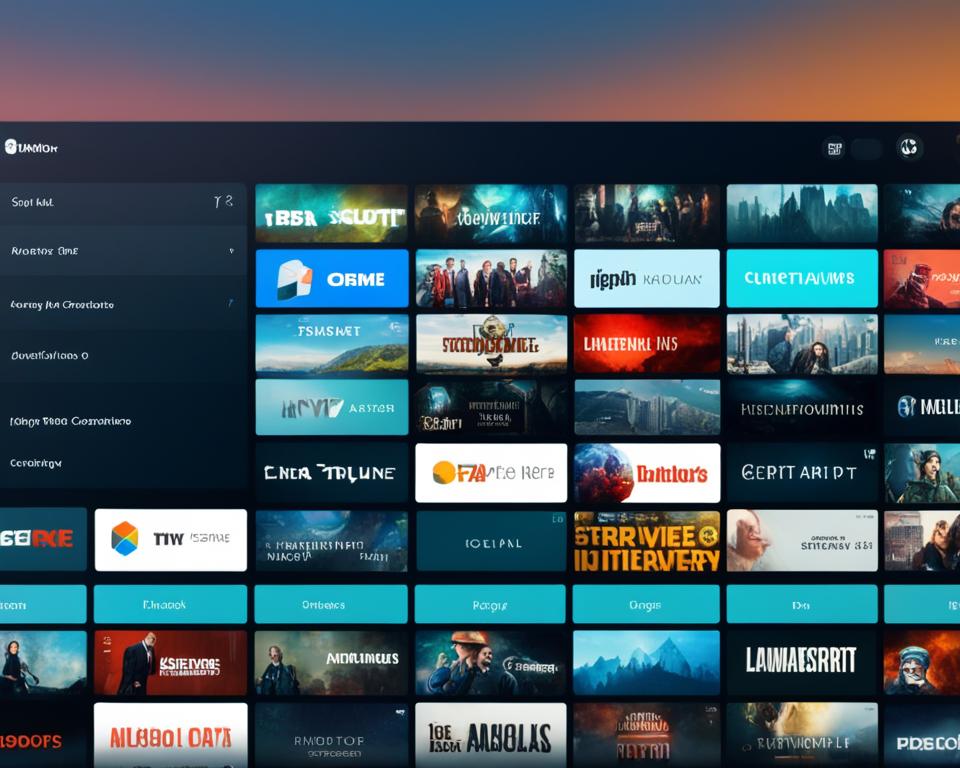
Benefits of Personalization in IPTV Platforms
- Enhanced User Engagement: By tailoring the content experience to individual preferences, IPTV platforms can keep users engaged for longer durations.
- Improved Content Discovery: Personalized recommendations expose viewers to a wider range of content options, expanding their horizons and helping them find new favorites.
- Increased Viewer Satisfaction: When viewers receive personalized content suggestions that align with their interests, they are more likely to have a positive viewing experience and remain satisfied with the service.
Implementing Personalization in IPTV Platforms
To deliver personalized experiences, IPTV platforms utilize a combination of user data, machine learning algorithms, and content metadata. These platforms collect data on user preferences, viewing habits, and interactions with the platform to build accurate profiles.
With this data, IPTV platforms can generate recommendations based on similar user behavior or content attributes. By leveraging AI-powered algorithms, these platforms continuously refine their recommendations to provide users with increasingly accurate and relevant content suggestions.
Furthermore, IPTV platforms often offer user-controlled settings that allow individuals to fine-tune their content preferences. This level of customization ensures that users have control over the types of content they see, adding an additional layer of personalization to the viewing experience.
Seamless Multi-Platform Integration: Access Anytime, Anywhere
In the modern era of multi-device consumption, seamless integration across multiple platforms is crucial for IPTV services to remain relevant and accessible to users. Whether viewers are streaming content on their smart TVs, smartphones, tablets, or desktop computers, a cohesive cross-platform experience ensures continuity and convenience.
By prioritizing multi-platform integration, IPTV platforms enable users to seamlessly transition between devices without any interruptions, allowing them to access their favorite content anytime, anywhere. This level of flexibility enhances the overall user experience by providing convenience and personalized accessibility.
Whether users start watching a show on their smart TV and continue it on their smartphone while on the go, or vice versa, multi-platform integration ensures a consistent viewing experience across devices. Users can access their IPTV accounts from any device with ease, picking up right where they left off and enjoying uninterrupted entertainment.
Seamless multi-platform integration also opens up new possibilities for content consumption. Users can effortlessly switch between different devices based on their preferences or circumstances, without any limitations or restrictions. This freedom allows users to enjoy their favorite shows and movies in any environment, whether it’s the comfort of their living room or while traveling.
In summary, multi-platform integration is a key feature of modern IPTV services, enabling users to access their favorite content anytime, anywhere, and conveniently switch between devices. This seamless integration enhances the user experience, providing flexibility and convenience in content consumption.
Benefits of Seamless Multi-Platform Integration
| Benefits | Description |
|---|---|
| Convenience | Users can access their IPTV accounts and content from different devices, allowing them to watch their favorite shows and movies wherever and whenever they want. |
| Flexibility | Seamless integration enables users to switch between devices without interruptions, giving them the freedom to enjoy content in any environment. |
| Continuity | Viewers can start watching a show on one device and seamlessly continue on another, ensuring a consistent and uninterrupted viewing experience. |
| Personalization | Multi-platform integration allows users to customize their content consumption experience based on their preferences, creating a tailored viewing journey. |
Accessibility and Inclusivity: Designing for All Users
Exceptional IPTV services prioritize accessibility and inclusivity in their design, ensuring that their platforms are usable and enjoyable for users of all abilities. By embracing universal design principles, these services create an environment that caters to diverse needs, enriching the lives of all users.
The Power of Inclusive Design
Inclusivity goes beyond mere compliance with accessibility guidelines. It involves considering the needs of all users and designing experiences that are welcoming and easy to navigate for everyone. By following universal design principles, IPTV platforms create interfaces that are intuitive, user-friendly, and inclusive.
Closed Captioning and Audio Descriptions
For viewers with hearing or vision impairments, features like closed captioning and audio descriptions are instrumental in enhancing the viewing experience. Closed captioning allows users to read the dialogue and sound effects, ensuring they can follow along with the content. Audio descriptions provide detailed narrations of visual elements, making the experience more engaging for individuals with visual impairments.
Customizable Accessibility Settings
Recognizing that user needs may differ, IPTV services offer customizable accessibility settings to accommodate various preferences. These settings allow users to adjust font sizes, contrast levels, color schemes, and other display elements to optimize readability and visual comfort. Such customization empowers users with visual impairments, cognitive disabilities, or other specific needs to tailor the interface to their preferences.
Creating an Inclusive Viewing Experience
By prioritizing accessibility and inclusivity, IPTV services foster a more inclusive viewing experience where users of all abilities can fully enjoy the content. From the visually impaired to those with hearing impairments or mobility limitations, no user is excluded. User-centric design ensures that everyone feels welcome and can engage with the platform effortlessly.
Accessibility and inclusivity are central pillars of exceptional IPTV services. By implementing features such as closed captioning, audio descriptions, and customizable accessibility settings, these platforms demonstrate their commitment to designing for all users. Through universal design principles, IPTV services break down barriers and create an inclusive environment where everyone can enjoy the rich and immersive entertainment experience they deserve.
The Genesis of IPTV: Pioneering the Future of Television
The origins of IPTV can be traced back to the convergence of television and the internet in the late 20th century. Early experiments with IPTV technology in the 1990s and early 2000s demonstrated the potential to revolutionize the traditional broadcast model. Visionaries in the telecommunications industry saw an opportunity to deliver television content over IP networks, laying the groundwork for what would become IPTV.

| Year | Milestone |
|---|---|
| 1994 | The first ever live-streamed baseball game takes place, marking a significant step towards IPTV development |
| 1995 | RealNetworks introduces RealPlayer, a media player that allows streaming of audio and video over the internet |
| 1999 | Netflix launches its DVD-by-mail service, laying the foundation for its later transition to online streaming |
| 2000 | Telecom companies like AT&T and Verizon begin investing in IPTV technologies |
| 2005 | YouTube launches, popularizing user-generated video content and further fueling the growth of online video streaming |
| 2008 | Apple introduces the App Store, opening up new possibilities for streaming apps and IPTV services on mobile devices |
The development of IPTV continued to evolve over the years, driven by advancements in technology and consumer demand for personalized, on-demand viewing experiences. Today, IPTV has become a mainstream entertainment platform, disrupting traditional television services and shaping the future of the industry.
The Rise of On-Demand and Personalized Viewing Experiences
One of the defining features of IPTV is its support for on-demand and personalized viewing experiences. Unlike traditional broadcast television, which follows a fixed programming schedule, IPTV empowers viewers to access content whenever and wherever they choose. This flexibility and convenience offered by IPTV platforms have led to its mainstream adoption and the disruption of traditional television markets.
With on-demand viewing, viewers no longer need to rely on preset broadcast schedules to enjoy their favorite shows and movies. They have the freedom to watch what they want, when they want it. This shift has revolutionized the way people consume entertainment, providing unprecedented control and convenience.
Moreover, IPTV platforms enable personalized viewing experiences by leveraging advanced recommendation algorithms and user preferences. By analyzing viewing habits, genre preferences, and user ratings, IPTV services curate personalized content suggestions tailored to each individual viewer. This level of personalization ensures that users are presented with content that aligns with their interests, resulting in a more engaging and satisfying viewing experience.
Benefits of On-Demand and Personalized Viewing
- Convenience: Viewers have the freedom to watch content at their own pace and schedule, eliminating the need to adhere to fixed broadcast timings.
- Choice: IPTV platforms offer a vast library of content, providing viewers with an extensive selection to choose from, spanning various genres, languages, and formats.
- Flexibility: Viewers can access IPTV services on multiple devices, including smart TVs, smartphones, tablets, and computers, allowing seamless transitions between screens without interrupting their viewing experience.
- Discoverability: Personalized recommendations and content discovery mechanisms empower viewers to discover new shows, movies, and documentaries based on their preferences, expanding their entertainment horizons.
- Ad-free Options: Some IPTV platforms offer ad-free viewing experiences, allowing viewers to enjoy uninterrupted content without commercial breaks.
The rise of on-demand and personalized viewing experiences has challenged the traditional broadcast model and revolutionized the way audiences engage with television content. IPTV’s ability to cater to individual preferences and offer greater convenience has resulted in its widespread adoption and is reshaping the television landscape.
Mainstream Adoption and Market Disruption: Redefining the Television Landscape
Over the past decade, the adoption of IPTV has experienced a significant shift, moving from a niche technology to a mainstream entertainment platform. This transformation has been fueled by the embrace of IPTV by major telecommunications companies, cable operators, and over-the-top (OTT) providers. These players have recognized the potential of IPTV and have leveraged it to offer a wide range of subscription-based and ad-supported services.
One of the driving forces behind the adoption of IPTV is the proliferation of smart TVs, streaming devices, and mobile applications. These advancements have made accessing IPTV content more convenient and user-friendly than ever before. Viewers now have the flexibility to enjoy their favorite shows and movies whenever and wherever they choose, redefining the way television is consumed.
Furthermore, the rise of IPTV has disrupted traditional television services. The on-demand nature of IPTV has challenged the fixed programming schedules of traditional broadcast television. Viewers no longer have to wait for a specific time slot to access their desired content. Instead, they can instantly stream it at their convenience, leading to a significant shift in viewer preferences and behaviors.
Benefits of IPTV Adoption:
- Access to a wide range of content: Users can choose from an extensive library of TV shows, movies, documentaries, and live events.
- Customized viewing experience: IPTV services offer personalized recommendations based on user preferences, ensuring that viewers discover content aligned with their interests.
- Convenience and flexibility: With IPTV, viewers can stream their favorite content on any device, anytime and anywhere.
- Cost-effective: IPTV eliminates the need for expensive cable or satellite subscriptions, providing a more affordable entertainment solution.
- Interactive features: IPTV services often include interactive features such as live chat, social media integration, and gaming, enhancing the overall viewing experience.
The mainstream adoption of IPTV has fundamentally transformed the television landscape, offering viewers more choice, convenience, and control over their entertainment preferences. As technology continues to advance, it will be fascinating to witness how IPTV continues to disrupt and shape the future of the entertainment industry.
Conclusion
User experience design is crucial for the success of IPTV platforms, as it influences how viewers interact with and enjoy digital television content. By prioritizing intuitive interface design, personalization and content discovery, seamless multi-platform integration, and accessibility, exceptional IPTV services stand out in today’s competitive marketplace. As technology continues to advance, user experience design will play an even more significant role in shaping the future of IPTV and the entertainment industry as a whole.
IPTV platforms that offer user-friendly interfaces and seamless navigation make it easier for viewers to find and enjoy their favorite content. By leveraging user data and advanced algorithms, these platforms can deliver personalized recommendations that align with each viewer’s unique preferences and interests. Furthermore, the ability to seamlessly access content across multiple devices enhances the convenience and flexibility of IPTV, allowing users to enjoy their favorite shows and movies anytime, anywhere.
Inclusivity is also a key focus for leading IPTV services, as they strive to ensure that their platforms are accessible and enjoyable for users of all abilities. By embracing universal design principles and offering features such as closed captioning and customizable accessibility settings, IPTV platforms create an inclusive viewing experience for individuals with hearing, vision, or mobility impairments. This commitment to accessibility not only enhances the user experience but also demonstrates the industry’s dedication to diversity and inclusivity.
Looking ahead, the future of IPTV holds immense potential. As technology continues to advance and viewer preferences evolve, user experience design will play a vital role in shaping the direction of the industry. IPTV platforms that prioritize the user experience and adapt to changing trends will be well-positioned to thrive in the dynamic and competitive entertainment landscape. By continually improving interface design, personalization features, multi-platform integration, and accessibility, IPTV services will continue to redefine and enhance the way we consume and enjoy digital television content.
FAQ
What is user experience design in streaming platforms?
How do IPTV platforms map the viewer experience?
What is intuitive interface design in streaming platforms?
How do IPTV platforms personalize the viewing experience?
How do streaming platforms ensure seamless multi-platform integration?
Why is accessibility and inclusivity important in streaming platforms?
What are the origins of IPTV?
How does IPTV differ from traditional broadcast television?
How has IPTV impacted the television landscape?
How does user experience design shape the future of IPTV and the entertainment industry?
